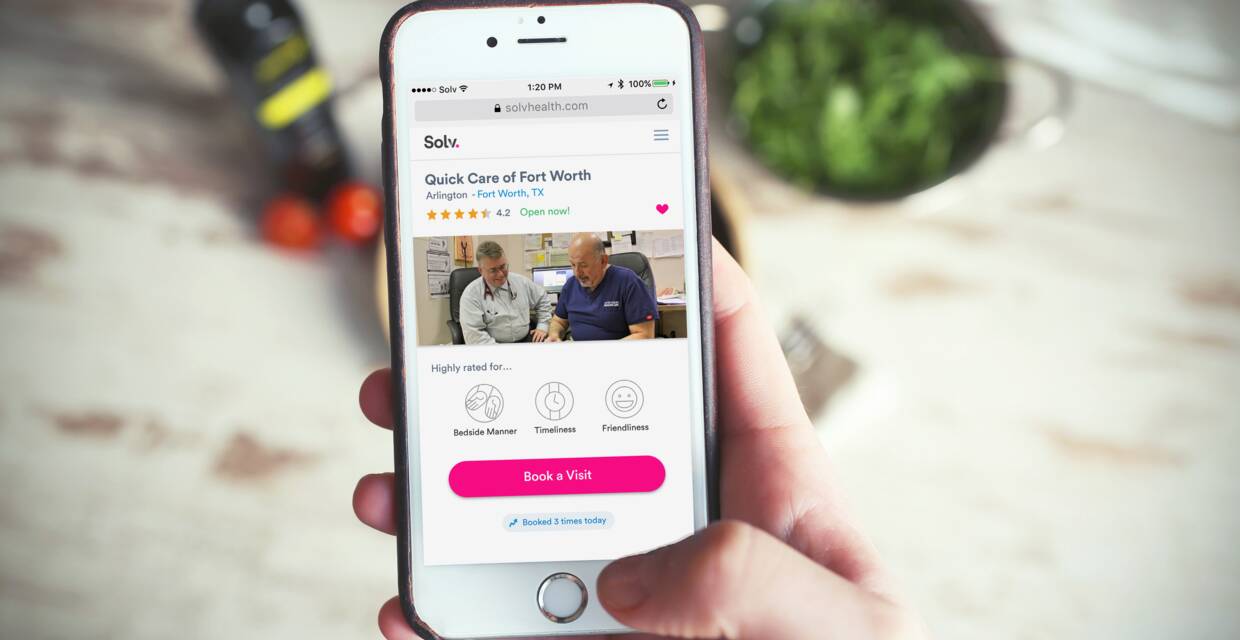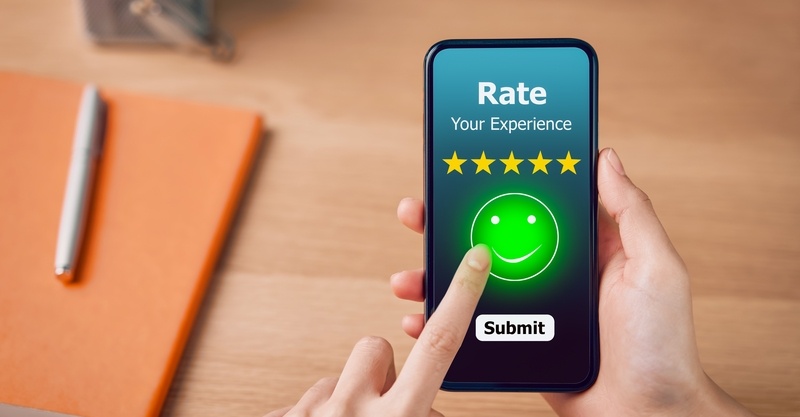Emerging technology has brought about tremendous steps forward in healthcare. From genome sequencing to holograms used in surgery, groundbreaking innovations are improving the ability of general physicians and specialists alike to treat their patients optimally. Despite high-tech advancements disrupting the way patients are treated medically, ironically, the technology they use to research their care options and interact with their care provider is incredibly outdated. In fact, some aspects of today's digital world are making it harder for customers to get the right care.
Solv is making it easier for customers to navigate the chaos that abounds online, by skipping straight to the personalized, trustworthy information they need. In this post, we'll look at how your clinic can make it easy for prospective customers to choose you and for existing customers to keep coming back. By meeting them where they are on their mobile devices, you'll result in more intakes--and we'll show you how.
Problems Customers Face in Our Digital Age
The fact that there's so much information readily available on the Internet may seem like a good thing, but in the context of healthcare, it can be downright dangerous. When Googling their health symptoms or concerns, most of the time it’s websites hoping to generate clicks and traffic through emotionally-driven headlines that capture their attention and bring them in the wrong direction. Not only is the online information out there overwhelming and confusing, but also it’s generalized, and doesn’t offer people a personalized and professional look at their health. Articles that “guide” people in diagnosing themselves result in them avoiding getting professional care altogether and ultimately ending up with a worsened condition.
From Google, to WebMD, to Facebook, the information is abundant. It’s a lot of noise, with little direction. Plus, much of it’s geared toward the end goal of selling generic health products that aren’t even FDA-approved, let alone doctor prescribed.
What the Data Shows
When Solv surveyed consumers, we found data that suggests today’s healthcare consumers are acutely undereducated when it comes to healthcare services. Half of the surveyed consumers weren’t aware of the differences between urgent care and retail clinics. When asked why they have not visited an urgent care center, 10% of respondents reported they’re not aware of an urgent care center near them. The truth is, 80% of consumers are within 10 miles of an urgent care facility, which reflects the knowledge gap that needs to be filled.
When quizzed on the services provided at urgent care centers, the results showed that 60% of respondents weren’t aware you could get a physical exam done. Forty-two percent didn’t know you could receive asthma treatment at an urgent care center. Again, 42% of the survey participants didn’t realize you could get a prescription at an urgent care center. The evidence is clear: healthcare facilities are missing out on much of their consumer base because the dots aren’t connected between people who need care and the places offering the exact care they need.
Advantages of the Digital Age
The upside to all this is that technology can also be used to help. Resources that create personalized and credible results for individual users, such as Apple Health and Google My Business, are some examples of technology that helps consumers instead of taking advantage of them. Instead of generic articles providing outdated and untrustworthy information, smart technology can put the user’s interest first and curate data according to their unique needs.
Innovative companies have begun to leverage new technologies like telehealth, AI, Blockchain, voice enablement and wearable health devices to help empower consumers with clearer information streams. However, most healthcare centers aren’t leveraging the latest technologies to acquire new patients, educate them about the services available to them and streamline services for them more conveniently than competitors.
Businesses in industries ranging from childcare to hospitality are leveraging websites like urbansitters.com and hoteltonight.com to have their services listed where consumers are searching. Instead of looking on sketchy Craigslist ads or asking around for a babysitter, parents can use a third-party site like urbansitters to navigate through the process seamlessly. On hoteltonight.com, consumers get to see reviews from third-party-verified customers. These types of trustworthy platforms let consumers learn about businesses and services through a third-party medium, so they can come to an educated decision. There are buttons that allow customers to immediately request a booking or schedule an appointment, so that they can take action on the spot.
This phenomenon is lacking in healthcare, where people need this technology the most. Consumers aren’t well educated, and they don’t know where to go for the info they need. Hence, the endless Google searching. Where is the technology that helps healthcare consumers filter out the noise and land on an answer they can take action on?
Mobile Devices: The Opportunity to Meet Consumers Where They Are
Today, the most simple, easy-to-access, convenient and intuitive consumer technology exists on mobile devices. Primarily, smartphones. They're the most ubiquitous and actionable technology, and it's in your prospective customer’s hands. Every person aged 18 to 29 has a smartphone. Seventy-three percent of 50-64-year-olds own one, and 50% of people over 65 have one.
Consumers now use their smartphones as powerful assistants to do things like sell their homes, file their taxes, and manage their security systems.
In Solv's survey, participants were asked to name the #1 technological advancement that makes their lives easier. Across all the groups, easy online and mobile booking was consistently preferred. The 45-60 age group felt most strongly about this, as 65% of respondents reported it as the most important technology for them.
Considering that 55% of all healthcare web traffic is mobile, and that 70% of urgent care searches come from mobile devices, it's unsurprising that people want a mobile-enabled customer journey as they research their healthcare options and schedule a visit.
By leveraging mobile technology, you can cater to your patients and improve your bottom line across search, selection, scheduling, and service.
How to Get Your Clinic Found on Mobile
That being said, how can you use mobile to establish clarity for customers and streamline their journey to a visit with you?
Google Ads
It all starts with a Google search on a mobile phone. 1 in 18 Google searches are health-related. It’s the #1 way that you will continue to be discovered and considered by consumers searching for care online. Studies show you can increase unaided brand awareness by 46% simply by showing up in mobile search ad results.
Content Marketing
Create content that helps you get discovered by consumers in need. Rather than going to articles that lead to harmful self-diagnosing, you can create online content such as videos or blog posts that guide customers along the journey of booking a visit at your clinic. Optimize your written content so that it’s being correctly read by Google’s algorithm. Q&A formatting and bullet lists help your content appear in unique, more helpful, more actionable ways.
Gain a Presence on Google My Business
People are going to Google now more than ever to find the businesses and services they need. They google things like “hair salon near me” because of their phone’s location feature. In fact, there’s been a 60x increase in nearby searches. To make sure your business is getting noticed by mobile users, you want to have a presence on Google My Business. Setting up a profile on this platform and building it out can help consumers learn about you and even book a visit at your clinic. Your profile displays photos of your business, and consumers see business hours and at-a-glance busy times. Google My Business is far more important than Yelp, because Google’s algorithm favors it. Without a doubt, businesses with an active profile rank higher on Google searches.
Scheduling and Booking on Mobile
Enabling people to book visits with you on their mobile devices gives them the chance to take action any time they’re on their mobile device, 24/7. Many users are on their devices after business hours are over, and mobile booking lets them set up an appointment without waiting until your clinic is open again. By being bookable to customers 24/7, you end up with higher patient intakes. During the mobile booking process, you can ask customers for their phone numbers so that they’re set up to receive reminders about their appointments.
Google My Business has a feature called Posts, which shows up when users do a Google search for your business or topics related to it. You can use Posts to drive bookings for your clinic from Google traffic. In fact, 21% of clicks on posts result in a booking. Also, according to a study by ZocDoc on the evolution of e-medicine, non-attendance rates for online appointments were much lower (6.9%) than non-attendance rates for appointments made through traditional means.
Using Mobile to Improve Patient Services
If you look around in the waiting room at your clinic, you’ll probably see that most of your patients are on their mobile devices while waiting for their visit to commence. Using mobile technology to automate some of the patient intake tasks your staff performs can help your staff focus on other tasks and avoid the stress that comes with multi-tasking.
Mobile Waitlist
One example is to offer a mobile waitlist, where patients can check in, view their place in line and even get an estimated wait time0. This helps alleviate the anxiety that arises from wait times. By giving patients real-time visibility of wait data, your staff can focus on their tasks.
Collect Paperwork and Insurance or Payment by Mobile
While your patients are waiting in the waiting room, you can streamline their intake process by collecting paperwork, insurance information and payments through mobile devices. User-friendly mobile forms are often easier than paper forms, and it frees up your staff from checking through the forms to ensure all fields have been filled out.
Consumers today are used to paying online with apps like PayPal, Venmo and Apple Pay. According to research by Solv, about 40% of consumers prefer paying through text or email.
Encourage Feedback and Rebooking via SMS and Accounts
Consumers reach for their mobile phones to read reviews when selecting healthcare providers, so why not ask for reviews on mobile? Send texts to collect patient feedback on their experience after their visit. This communication channel also lets you respond to complaints and get a better sense of what’s going on in your clinic. Research shows that SMS performs 5x better than email in collecting reviews.
After a new patient’s first visit, consider asking them to set up an account with your clinic on an online portal or mobile app. This way, their information can be stored that will allow them to set up 1-click booking for future visits.
Solv’s Solution for Your Clinic
Solv is devoted to helping healthcare consumers get frustration-free access to the quality care they need. As a care provider, you’re on a mission to deliver the best patient experience, and we want to help you achieve it. We focus on the full picture: from pre-visit and far beyond post-visit, streaming your customer’s journey.
Through Solv, we can help increase your clinic’s visibility and web traffic, resulting in more patients and trickling generously to your bottom line. It offers consumers 24/7 mobile chat and booking, facilitates patient SMS communication and lets your patients set up their account with your practice for 1-click rebooking. Our Mobile Waitlist, Accounts, Solv Pay, Uber partnership, and feedback features make it possible for you to give your patients a convenient and streamlined process. By engaging them with mobile across all touch points, you keep them connected and in-the-know.
As consumers become increasingly mobile-oriented, healthcare providers that jump on the mobile trend now have an edge over competitors. By getting noticed on Google, providing an easy 24/7 mobile scheduling experience and following through with SMS communication before and after their visit, you can keep customers coming, and then coming back. Visit SolvHealth.com/for-providers to claim your page for FREE.


 LinkedIn
LinkedIn

